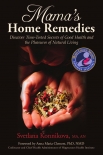Mama's Home Remedies: Discover Time-Tested Secrets of Good Health and the Pleasures of Natural Livin by Svetlana Konnikova (series like harry potter txt) 📗

- Author: Svetlana Konnikova
Book online «Mama's Home Remedies: Discover Time-Tested Secrets of Good Health and the Pleasures of Natural Livin by Svetlana Konnikova (series like harry potter txt) 📗». Author Svetlana Konnikova
It astounds me when I see this dismissing and ill-disposed attitude adopted by so many of our doctors and scientists. These are the professionals who are bound by their duties as health-care providers and researchers to be concerned with providing the best of care to their patients, and yet they disregard the knowledge of the past. They are obliged to review this knowledge and bring it back from the dust of centuries to be employed once again as a natural preventative and healing tool. There are in the world thousands of simple natural matters and means and thousands of ancient remedies that are awaiting research and distribution.
Thousands of natural substances are hidden in flora and fauna and in other treasures of Mother Nature, but yet they are still unknown to us.
“Even the Badger Knows…” @ 13
Usually novice botanists consider all types of moss as peat moss. They confuse sphagnum (peat moss) with green downy which is like a tiny fir tree and is called “cuckoo flax” in Russia. This “cuckoo flax” has one small “box” on the “foot”—sporangium. The other kind is soft, bright-green branchy moss, which has several sporangiums.
A well-known Russian botanist and writer, Nikolai Verzilin, wrote in his book, Follow Robinson,2 “Sphagnum, when it is wet is pale-green on top, and white on the bottom. It covers solidly the peat bog, usually where cranberries and cloud-berries grow.”
In 1919, in a young Soviet Republic, a fierce fight raged in the north between the Russian tsar’s white guards and the Red Army soldiers. There were many wounded Red Army soldiers, and the field hospital was running low on supplies of cotton/wool bandages and iodine. There was nothing else the hospital nurses could do but to cut underwear in narrow strips for bandages while old bandages were washed and dried. But cotton wool, an irreplaceable material for treating festering wounds, was not available. When the supply of bandages and all dressing materials was depleted, the hospital doctors and nurses were forced to find an alternative. They had no means to obtain additional bandages and did not know what to use instead. Physicians were frustrated and distraught as they witnessed the soldiers suffering from wounds that were left unattended because of the lack of bandaging. One physician decided to take a walk and think about the problem. Winter had just begun and the northern village where the hospital was located was bleak, grey, and gloomy. The trees stood naked in solemn silence waiting for a severe frost, which would surely be upon them any day. The doctor arrived on the outskirts of the village to find a marsh covered with a first snow. The doctor became irritated and trampled down on the hummock. The situation appeared hopeless until he realized that he was standing atop clean, white moss sphagnum. Instantly he recalled that many years prior, during his student years in medical school, he had examined a leaf of sphagnum moss under a microscope and found large empty cells. He took a closer look at the moss under his feet now and saw frozen water in their empty cells. He knew that dried moss is used extensively by farmers to absorb dung water. The doctor immediately guessed that dried moss could be used successfully to absorb the liquids from festering wounds.
14 ^ Mama’s Home Remedies
Unexpectedly this unknown Russian doctor had made
a scientific discovery and found a substitute for cotton
wool bandages. He was excited about his find and told
the hospital staff about the white sphagnum moss.
The next morning a deep snow fell from the
heavy gray sky. It became very cold, but it did not deter the hospital staff from their mission. All hospital attendants, stretcher-bearers, and nurses went to the marsh to collect sphagnum. They dug into the
snow and removed almost 600 pounds of frozen layers
of moss in less than three hours. The harvest was enough to keep the wounded soldiers swaddled in clean bandages through the severe winter. To prepare the moss and adapt it to the needs of the patients, the moss was allowed to thaw. Then the water was squeezed from it and the sheets of moss were placed to dry on the floor of a warm room. In 24 hours it was ready to use as a substitute for the precious cotton wool.
It proved to be an effective bandaging material, but in addition sphagnum partially replaced the healing effects of iodine as well. Wounds dressed with the moss were noted to heal more rapidly because the moss contains a special disinfectant which is identical to carbolic acid and inhibits the growth of purulent bacteria.
When I was a child, my friends and I would tell spooky stories around the fire on our camping trips. My grandpa used to tell us horror stories that took place in marshy areas. He told us about ancient boats, wooden cabins and shacks, animal bones, and human skeletons that had been found in marshes. He told me about the body of a knight, suited in full heavy metal armor that had been found in a marsh.
His stories greatly affected me. I spent many sleepless nights trying to understand why a





Comments (0)